Knowing how to make porridge was never really a skill I needed in my house growing up. It was just what your Mum made for breakfast when it was cold. Not needed, that is, until I left home, that is and tried to make it for myself.
I ruined a good pan that day trying to figure out how to make porridge!
Porridge is not a complicated recipe, and once you crack it, you’ll realise just how easy it is to enjoy porridge’s deliciously warming breakfasty bliss. Then you have the fun of trying different variations and toppings to really find your very own perfect porridge recipe.
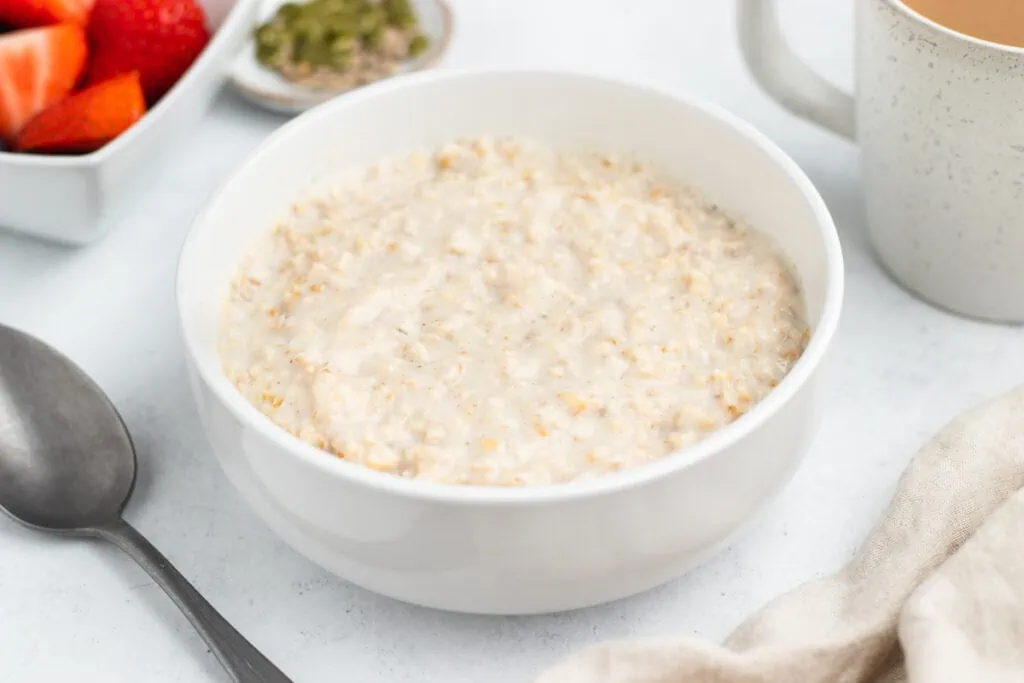
So, for all of you with a pan with burnt porridge coating welded to its bottom, Here’s how to make porridge, both on the stovetop or in the microwave, plus some of the best toppings we’ve tried and tested on our family.
Firstly, before we learn how to make porridge, we should know exactly what it is we’re making. We’ve tried to answer as many of the questions we’ve been asked about this Scottish breakfast classic as possible. Who knew there was so much to learn?
Whether you grew up with a dash of salt or a squeeze of honey, a splash of milk to cool it down, or only ever with water, there’s a porridge recipe for everyone!
- What is Porridge?
- Why is Porridge Called Porridge?
- Why is Porridge so Popular in Scotland?
- What are Porridge Oats?
- What is the ratio of Porridge to water or milk?
- What you need to make Porridge – on the stovetop
- Ingredients for the perfect Porridge recipe
- How to make Porridge on the stovetop
- How to make Porridge in the microwave
- Recipe Card for How to Make Porridge
- Porridge toppings you have to try.
- What are some Scottish Porridge Recipe Traditions?
- FAQS – How to make Porridge
- What is Porridge called in the USA?
- Was Porridge invented in Scotland?
- How do people traditionally eat Porridge in Scotland?
- What do the Scottish add to their Porridge?
- What is a Porridge Drawer?
- How do you make Porridge taste nice?
- What is the ratio of Porridge to water or milk?
- Are Oatmeal and Porridge the same thing?
- Weird toppings for Porridge?
- How many Calories are in Porridge?
- How Healthy is Porridge for You?
- Is Porridge healthier with water or milk?
What is Porridge?
Porridge is literally any food made from heating crushed grains or plants. For this post the porridge we’re talking about how to make porridge you’d typically find served in the UK on a cold winter’s morning.
Scottish porridge was traditionally made with ‘Scottish oats’ that had been ground, not rolled or cut. This makes for a much quicker cooking time and a creamy consistency.
These days most porridge oats in the supermarket, including the famous Porage Oats, are rolled, keeping the oats fresher for longer.
You can use either; ground oats will produce a smoother texture and be more authentic to days gone past. For this recipe, we used rolled oats as it is the easiest for people to find in the shop.
The oats are then boiled with water or milk to make porridge, a thick creamy dish served warm generally for breakfast.
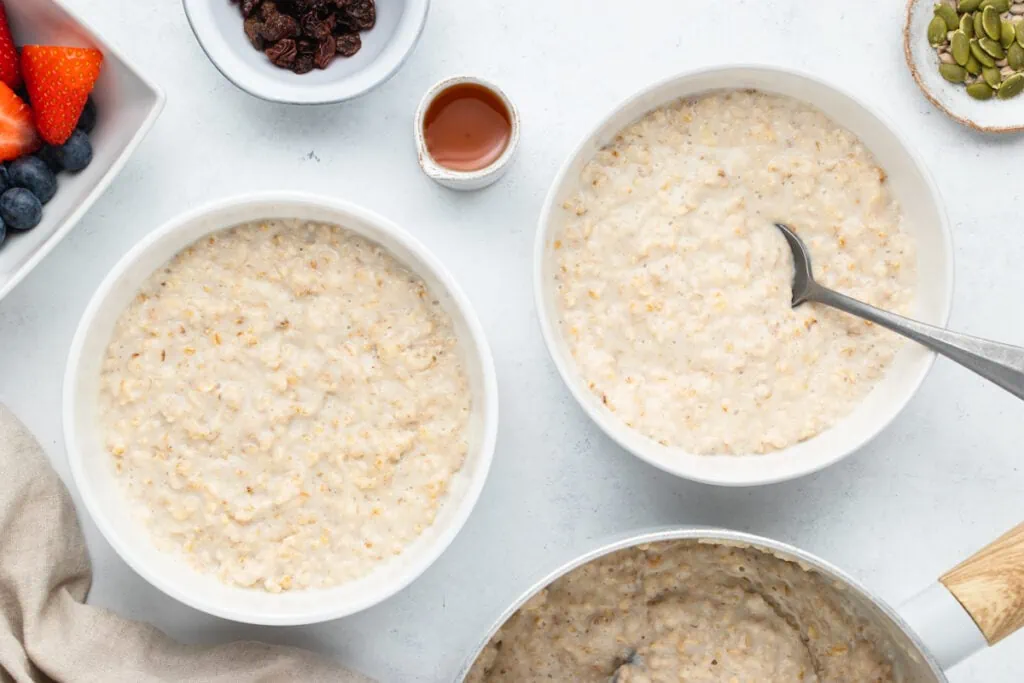
Why is Porridge Called Porridge?
The word porridge actually means:
“a dish made from oatmeal or another cereal, cooked in water or milk to a thick consistency” – Collins Dictionary
Though here in the UK, we have adopted the word to only really refer to a dish made from oats.
Porridge seems to be derived from an old English word, Pottage meaning a soup or stew, or from the French word Potage meaning that which is put in a pot. Over the centuries here in the UK, the word seems to have slowly turned into porridge as we use it today.
Why is Porridge so Popular in Scotland?
So what made oats and Porridge so popular in Scotland? The simple answer is the humble oat’s ability to grow with limited sunlight and in a large amount of rainfall. Sound like anywhere we know and love?
The very cost-effective oat fast became a regular part of the diet in Scotland from the early medieval period onwards. This popularity can be seen in the use of oats in Traditional Scottish dishes like Haggis, Oatcakes and Cranachan, as well as porridge, which itself may have developed from an older recipe called Brose.
Though Scotland can’t claim it invented Porridge, it has probably been the world’s biggest fan for hundreds of years. From being the ingredient of the lower classes, oats and Porridge have come full circle and are now deemed both sustainable and a superfood, chock full of nutritional value.
What are Porridge Oats?
Here’s a short breakdown of each type of Oat used for making Porridge:
Oat Groat – The part of the oat cut from the kernel cut from the husk of the whole grain.
Rolled Oars / Jumbo rolled / Old Fashioned Oats – Probably the most popular or common oat, these oat groats are flattened by rolling and have been through a steam process. They have a more gentle flavour but take less time than some other oats to make porridge. We use these oats in this recipe.
Scottish Oats – Made from whole Oat groats, which are then crushed or ground via two large stone wheels or millstones. The result is a texture slightly rougher than flour, and a smoother, quick-to-make porridge, deemed the most traditional way to make Scottish porridge.
Steel Cut Oats / Irish Oats / Course Oatmeal / Pinhead Oats – These are oat groats sliced into half or thirds by steel blades. They take longer to cook and need a higher liquid ratio to make porridge. This means you require fewer oats to make a bowl, meaning you stay full longer.
Instant – The most processed oat we’re discussing, the instant oat is often cooked, dried, rolled and then rolled again. This means the instant oats cook very quickly but lose their texture, not unlike Scottish Oats. They have the same nutritional value if nothing is added, but they are often sweetened or flavoured.
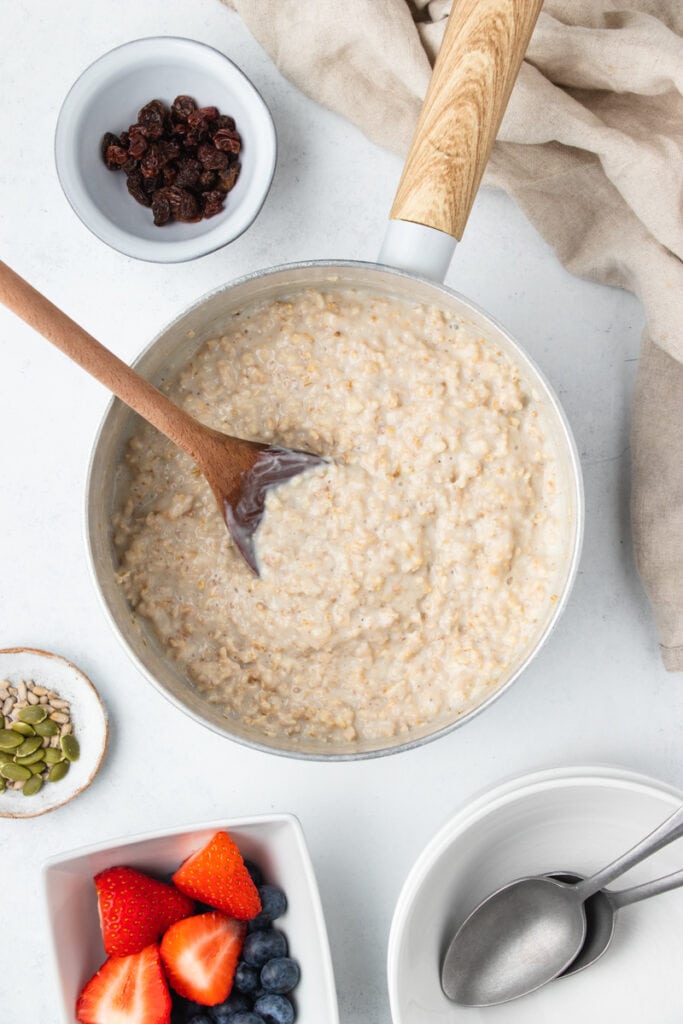
What is the ratio of Porridge to water or milk?
The ratio we use, and we’ve seen in numerous recipes, is somewhere between 1:2 and 1:3, depending on your own preference. We like a mix of water and milk to avoid it becoming too stodgy and a ratio of 1:2 with a 50/50 split between milk and water.
Using just water leaves your porridge lacking a certain something be it taste or texture. Using all milk and it can be a little stodgy, especially with full fat milk. A mix between the two and stirring A LOT is what will help you make the perfect porridge.
What you need to make Porridge – on the stovetop
Ingredients for the perfect Porridge recipe
- 200g (2 1/2 cups) porridge oats
- 360ml (1 ½ cups) semi-skimmed milk
- 360ml (1 ½ cups) water
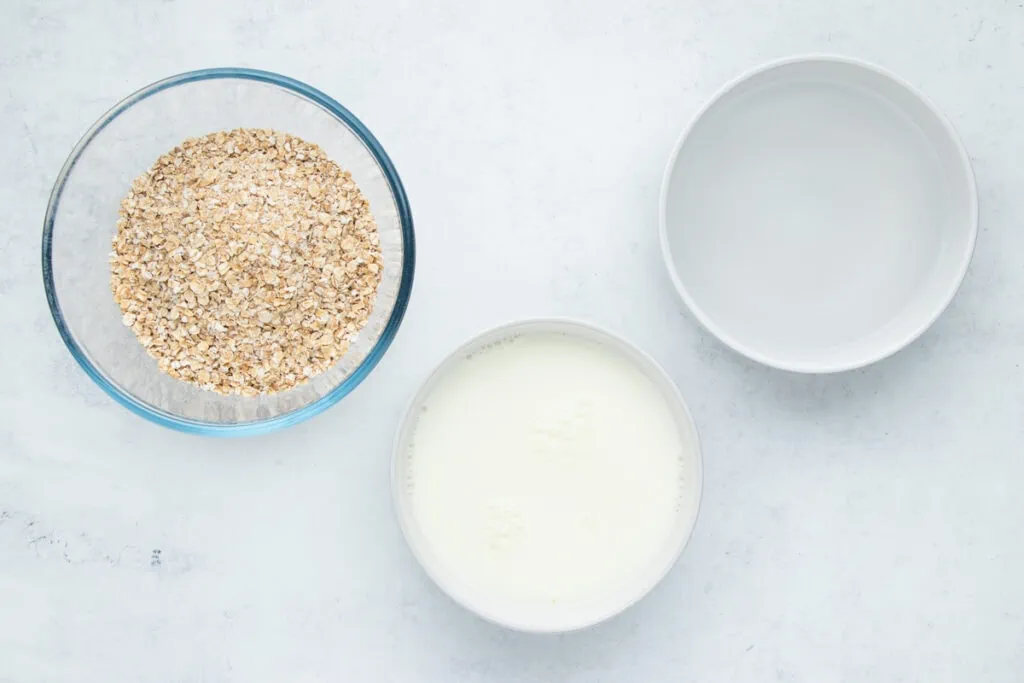
How to make Porridge on the stovetop
- Add all ingredients to a large saucepan and stir together.
- Bring to a simmer over a low to medium heat.
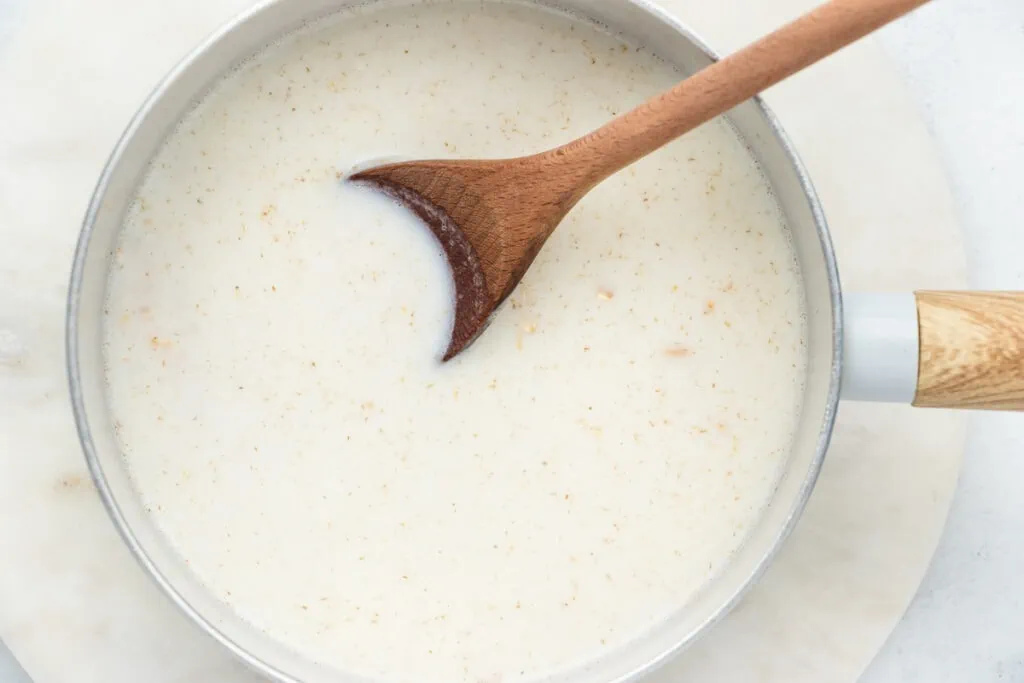
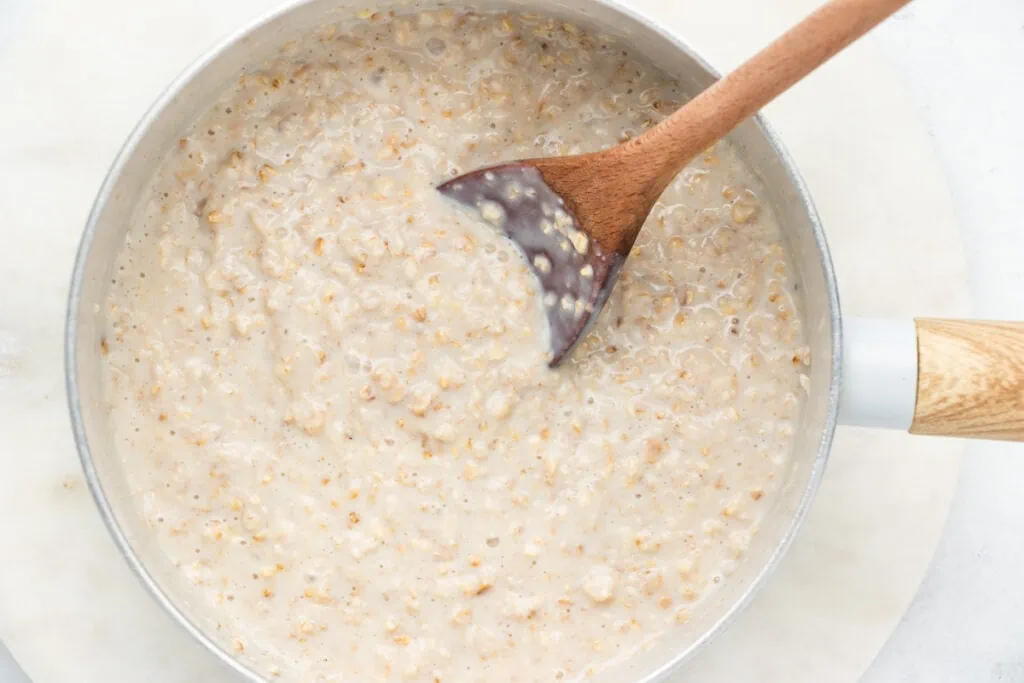
- Continue to simmer, stirring frequently, for another 5-7 minutes until the oats have softened and the porridge is creamy.
- Taste to make sure you’re happy.
- Serve with your favourite toppings.
How to make Porridge in the microwave
- Add all ingredients to a microwave-safe bowl and stir well.
- Microwave for 2 minutes, stir, then microwave for another 1 minute and 30 seconds
- Taste to make sure you’re happy. Be careful; it’s hot.
- Serve with your favourite toppings.
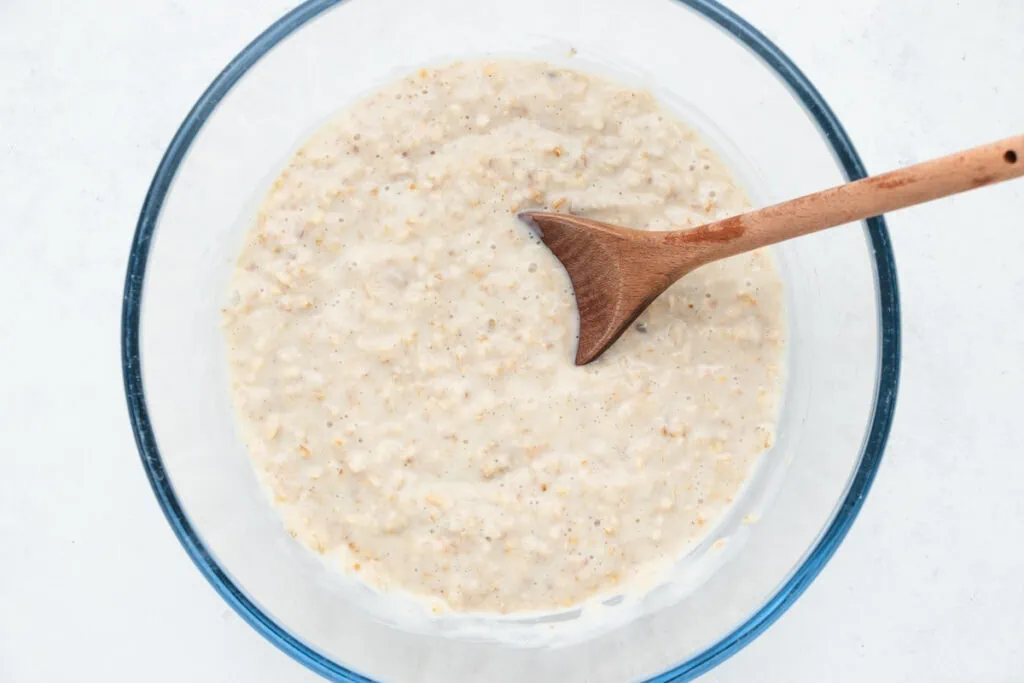
Recipe Card for How to Make Porridge
How to Make Porridge - Scottish Porridge Recipe
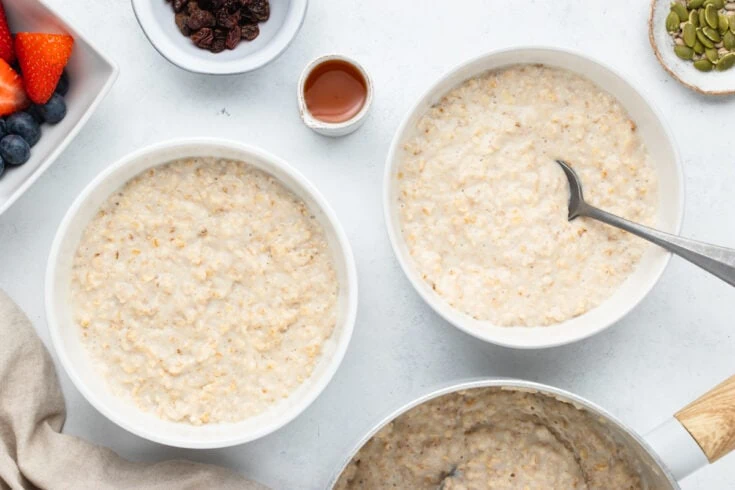
You might think you know how to make porridge, but you could be surprised! There are actually lots of little things you can do and change to make the perfect porridge.
We think the perfect porridge is a mix of water, milk, and oats. The amounts of each can vary but use our recipe as a starting point and then adapt it to your own tastes.
Ingredients
- 200g (2 1/2 cups) porridge oats
- 360ml (1 ½ cups) semi skimmed milk
- 360ml (1 ½ cups) water
Instructions
To make on the hob:
- Add all ingredients to a large saucepan and stir together.
- Bring to a simmer over a low-medium heat.
- Continue to simmer, stirring frequently, for another 5-7 minutes until the oats have softened and the porridge is creamy.
- Serve with your favourite toppings.
To make in the microwave:
- Add all ingredients to a microwave safe bowl and stir.
- Microwave for 2 minutes, stir, then microwave for another 1 minute and 30 seconds.
Notes
See our post for some of our favourite topping ideas!
Nutrition Information:
Yield:
4Serving Size:
1Amount Per Serving: Calories: 59Total Fat: 1gSaturated Fat: 0gTrans Fat: 0gUnsaturated Fat: 0gCholesterol: 1mgSodium: 26mgCarbohydrates: 10gFiber: 1gSugar: 3gProtein: 3g
The above values are an indication only.
Porridge toppings you have to try.
Roasted Oats – This isn’t a topping but a wee tip. For a stronger, richer oat flavour, try gently roasting the oats before they’re added to the saucepan.
A Pinch of Salt – The addition that every die-hard Porridge-eating Scot will swear to. Adding salt will add a depth to the flavour of your porridge but when you add it is vital. Too soon and it can toughen the oats, too late or as you serve it and it gets lost or worse only sits in one or two spoonfuls.
Adding a pinch of salt to the pot just as it comes to the end of cooking means it seasons it perfectly and that you can taste test to make sure you get just the right amount.
A Splash of Milk – This was a family favourite for us mainly, it has to be said, because when you’re in a rush in the morning, a dash of milk will help cool down a steaming bowl of porridge! Less burnt tounges before school.
Brown Sugar and Banana – If salt isn’t for you, then this sweet topping brings the porridge alive and is enough for any sweet tooth. it’s best to slice the banana rather than mash or cube it. You want it to sit on a spoon, not blend into the porridge.
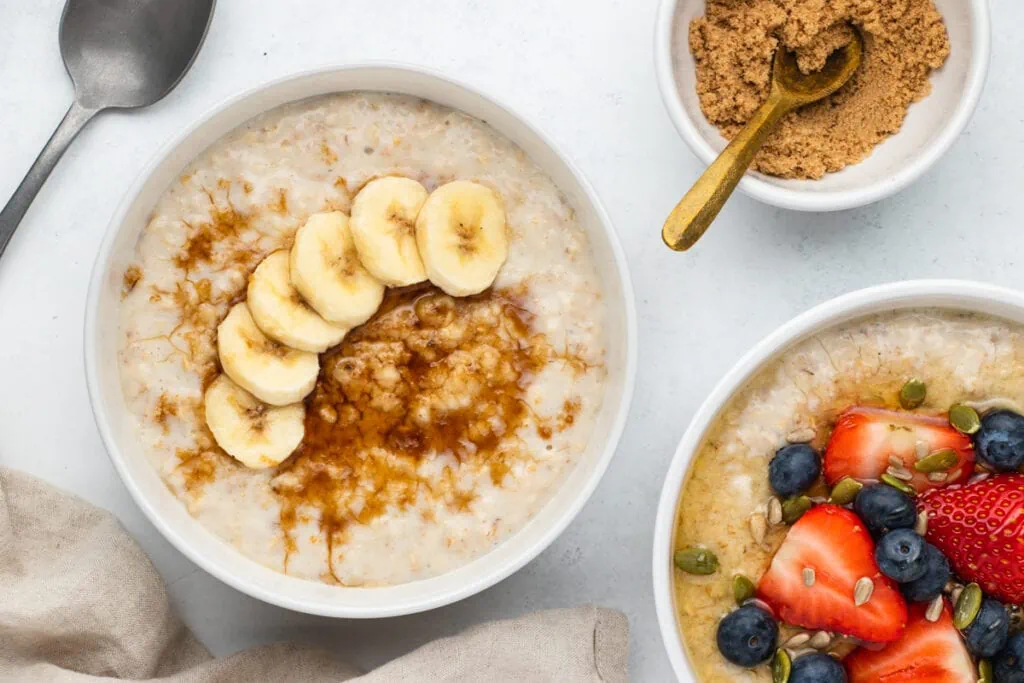
Fruit – You can’t really go wrong adding fruit to your porridge though we think a little tartness works best if banana isn’t for you. Blueberries or raspberries really pack a punch, peaches in syrup also works well.
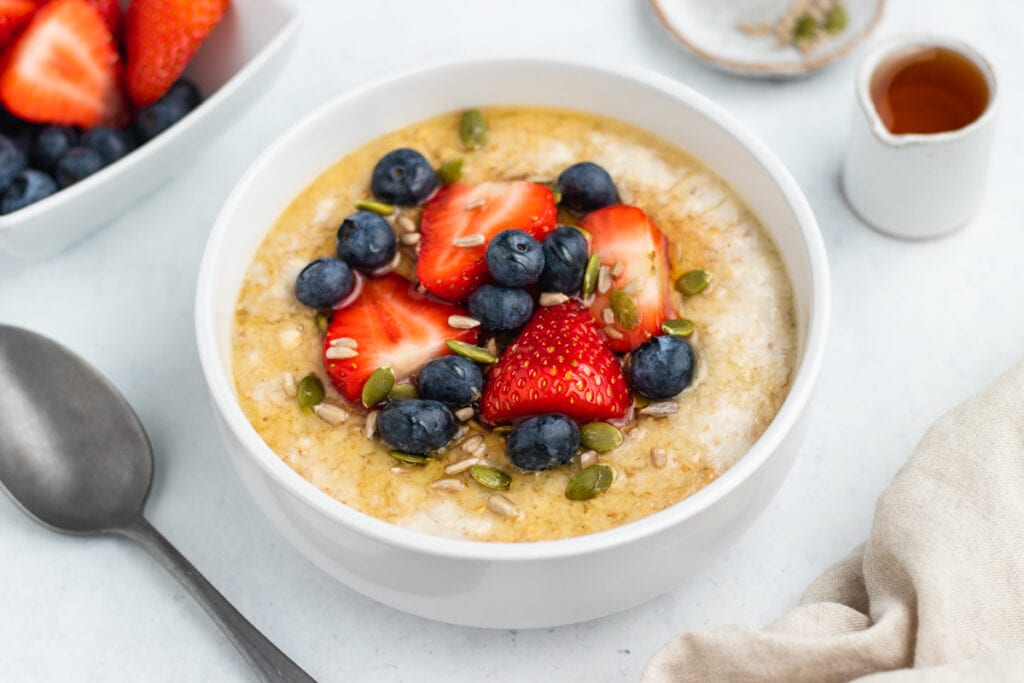
Full cream, golden syrup and raisins – We love this combination. It adds to the creaminess and provides a little texture and a dose of sweetness that helps set it all off wonderfully.
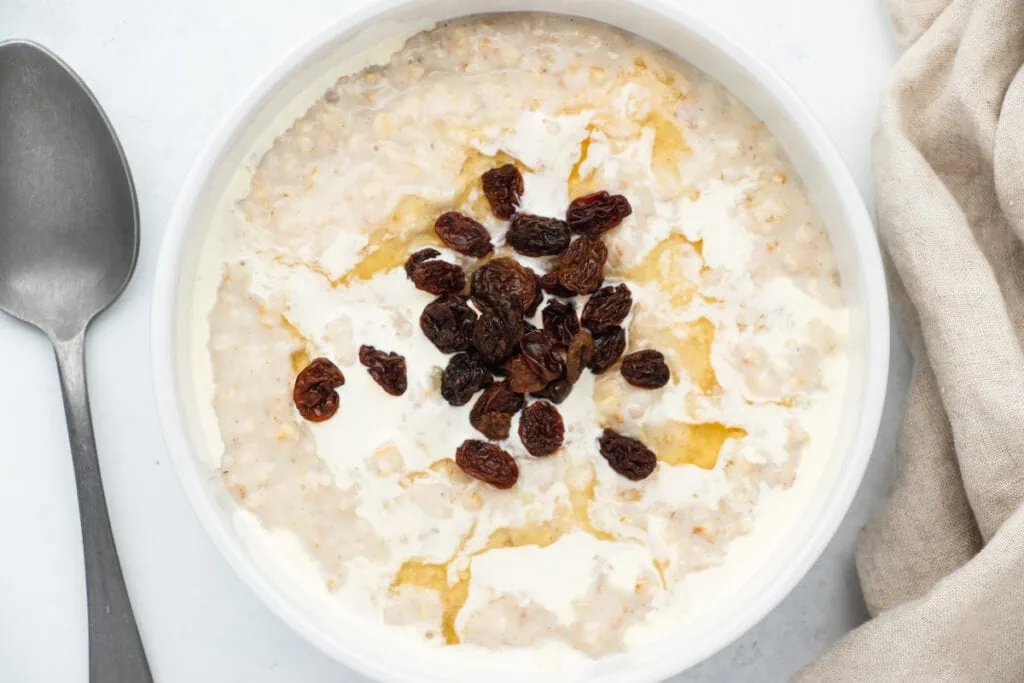
Seeds – All of the above toppings can have seeds added to them for a little extra texture and a boost to the protein value of your bowl. We suggest sunflower seeds or pumpkin, gently roasted if you have the time.
Yoghurt and honey – Why not keep it simple, after all, it’s a taste combination that seems from ancient Greece, so who are we to say it doesn’t belong on your porridge!
What are some Scottish Porridge Recipe Traditions?
There are some excellent Scottish traditions and superstitions to do with porridge. The most traditional from the 15th century is the use of a wooden spurtle, a long wooden rod, to stir the porridge.
The Spurtle is said to prevent the porridge from getting too lumpy, working better than a spoon because of its shape. You would always stir clockwise with the right hand to fend off the Devil.
Sadly we only had a spoon to hand when we made this recipe, but the Devil was fended off successfully!
These days the people of Scotland are a little more open to the many different porridge recipes and variations, which is just another example of how rich and varied Scottish food is.
FAQS – How to make Porridge
What is Porridge called in the USA?
In the United States, what we here in the UK call porridge is known as Oatmeal or Hot Cereal. They call it Oatmeal because this is what the porridge they’re used to making is made of. In the UK porridge has come to mean specifically oats boiled with water and milk, but the word actually describes any grain or cereal being boiled.
So actually, our cousins over the water are being more accurate. We’re still going to call porridge porridge though 😉
Was Porridge invented in Scotland?
The very quick answer to this is no.
Variations of porridge recipes have been around in Scotland and the rest of the UK for centuries, but there is evidence of oats being grown for thousands of years across Europe. There are over 1001 variations of Porridge globally, so it’s been about a wee bit.
Oats may not have always been used for the breakfast dish we know and love today, as other cereals were much more popular.
The Roman army, for example, used oats for animal feed as it was much more hardy than other available options while on the march. These marches may have helped spread the humble oat as the Roman Empire grew.
How do people traditionally eat Porridge in Scotland?
How porridge is served in Scotland today causes a little debate as times and tastes change. A Scottish porridge recipe from the past would once have been made in one large pot with just ground oats, water and a sprinkle of salt, as this is said to add depth to the flavour.
Over time the addition of either milk, cream, sugar or buttermilk on the side became an option.
Some die-hards deem salt the ONLY addition to a bowl of Porridge and a clear sign of Scottishness. We’re a little more open to trying as many different toppings as possible, but each to their own bowl of porridge!
What do the Scottish add to their Porridge?
Traditionally only ground oats, water and salt. Tastes have changed, however, and now the Scottish enjoy experimenting with the porridge recipe as much as any other country!
What is a Porridge Drawer?
A porridge drawer is a very Scottish thing. Any leftover porridge was poured from a large stovetop pot into a lined drawer, allowed to settle, scored into bars and left to cool. Once cooled, the porridge can be cut out and eaten as bars as a snack.
Do you have a porridge drawer in your house?
How do you make Porridge taste nice?
Making porridge taste nice all depends on how you like it to begin with. For smooth and creamy porridge, just follow our recipe, mixing a little water and milk and stir stir stir!
Then add the topping or flavouring of your choice, be it salt or sugar, fruits or even whisky!
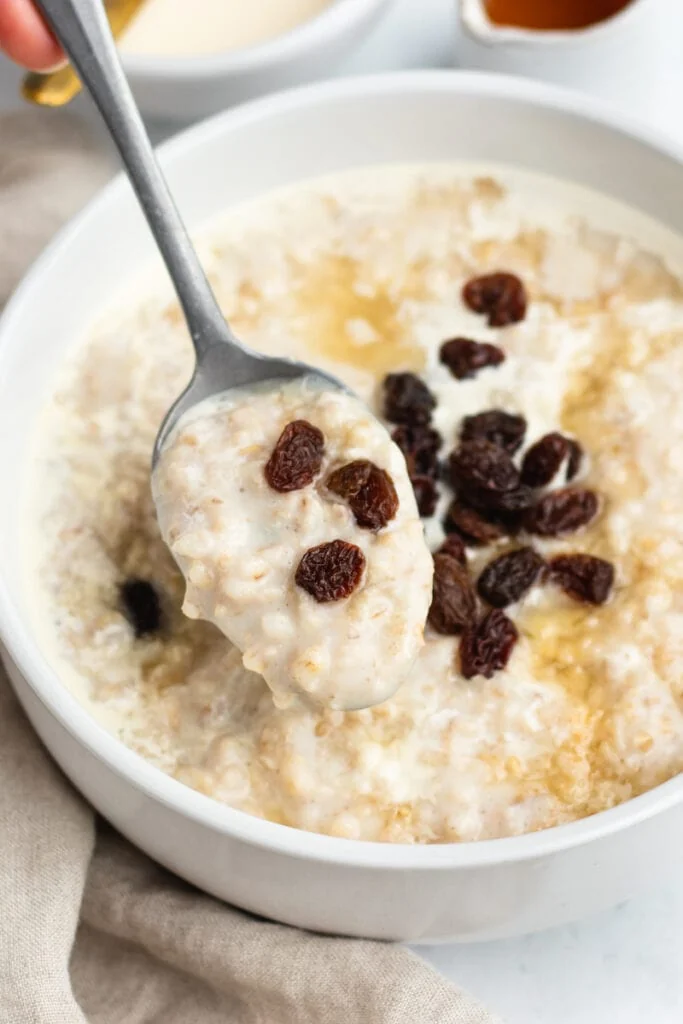
What is the ratio of Porridge to water or milk?
The ratio we use, and that we’ve seen in numerous recipes we researched, is somewhere between 1:2 and 1:3 (Oats : Liquid), depending on your own preference.
We like a mix of water and milk to avoid it becoming too stodgy and a ratio of 1:2 with a 50/50 split between milk and water.
Are Oatmeal and Porridge the same thing?
Essentially yes, if you’re talking about the breakfast dish made with oats. Oatmeal is certainly a type of porridge. We here in the UK have just taken the general word porridge and decided to only use it for porridge made from oats, as opposed to any other boiled grain or cereal.
Weird toppings for Porridge?
Some of the more interesting toppings we’ve read about are butter, chocolate or whisky. We can understand adding butter over the centuries and even a dram of whisky, but here at Scottish Scran, we think if you’re going to add chocolate, then maybe just buy some Coco Pops!
How many Calories are in Porridge?
A standard bowl of Porridge made with semi-skimmed milk typically contains 280Cal, according to My Fitness Pal.
Add a topping of honey to this, for example, and it rises to 335Cal.
A 40g serving of Scottish porridge oats made with water contains typically contains 148 calories, according to My Fitness Pal.
How Healthy is Porridge for You?
Porridge is a deliciously healthy way to start the day. Whichever type of oat your porridge recipe calls for, you will still be eating amazing whole grains, and these can help reduce cholesterol as part of a healthy diet.
If your Porridge is made with low-fat milk or water, then this will keep the calories down. Then you just have to be careful with your toppings.
After all, there’s no point in having a healthy breakfast and then adding chocolate, for example! Fruit is the way forward in this case.
If you’re making instant Porridge, then check the calorie count and stay away from the flavoured and sweetened versions to keep your Porridge as healthy for you as possible.
Is Porridge healthier with water or milk?
Using low-fat milk or water is recommended by the British Heart Foundation. Milk obviously has more calories than water but it should all be considered as part of a healthy and balanced diet.
And that is how to make porridge. A very simple recipe that raises an awful lot of questions. Part of the reason for this is how old the recipe is as well as the variations between different oats and country’s preferences.
We have tried our best to answer all the major questions as well as giving you a perfect porridge recipe, if you have any other questions please pop them in the comments.
All the best,
Phil & Sonja
Pin for later
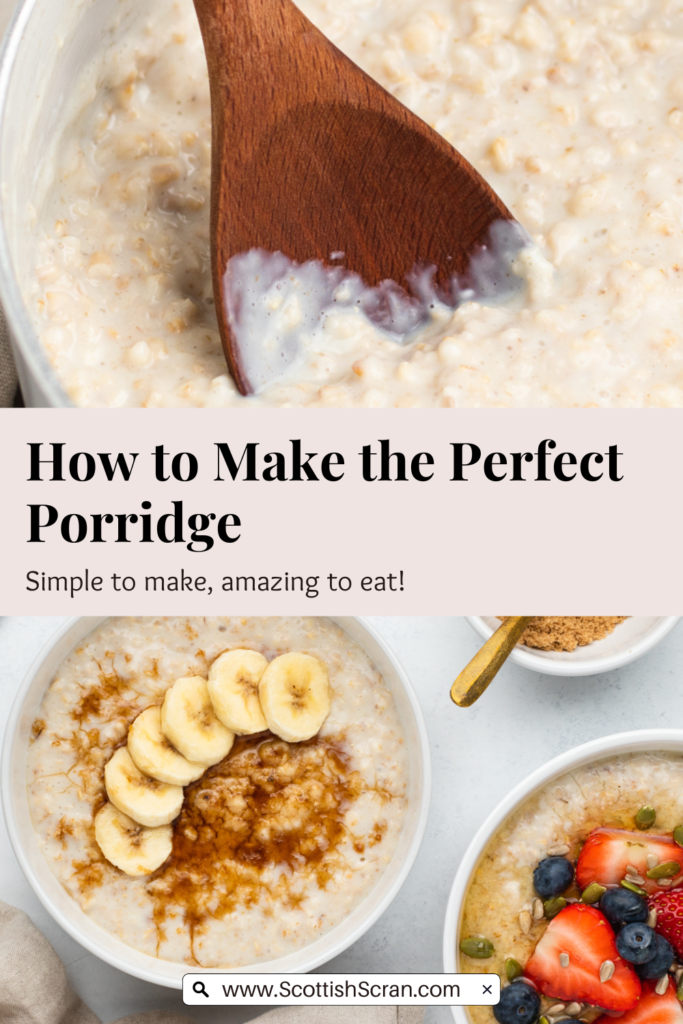

Porridge is my favorite breakfast and my taste preference I discovered accidentally.
I would cook it, add a slight dab of butter and pack it up to take with me to work.
When I sat down to finally get to eat it, it had cooled to a nice comforting warm temperature, the butter had melted to add a bit of richness to the flavor and the thickened consistency was like eating a piece of cake. That outcome for me was perfect. I have been eating it way that for years now. It is the ultimate comfort breakfast food. I do add fresh blueberries for their nutritional value or occasionally dried cranberries. But the porridge itself is the star.
My mother taught me to make porridge as she learnt from her mother (ad infinitum). We make it as you suggested – 1 cup of porridge to 1 cup of Milk and one cup of water and add a pinch of salt. As a special treat for breakfast or when we have friends to stay, we add a spoonful of sugar, a helping of double cream and a tot of malt whisky, mixed in just before serving….scrumptious! My husband also likes his porridge with smoked bacon lardons! Thank you for your recipes. I love your website.
Since growing up in the Borders, and “aging” in Australia I have porridge every morning without fail, with the occasional additive of dried fruit. NO sugar NO salt, No milk, just hot water mix.
But if I followed Granny Johnson’s advice (which I only do on cold mornings) add a half spoonful of whisky to keep out the cold. (a common factor in the “old days”) –
I can remember as a child there was not always a “full pantry” – so at night before bed a bowl of porridge with a spoonful of jam filled the otherwise empty tummy
hi ,I am Trev from Windsor, i prepare my porridge at night, I first sprinkle a teaspoonful of sugar in the pan then pour over a cupful of oats then I pour over rust to cover the top of the oats boiling hot water put the lid on pan that is left till the morning just heat up gently stirring till piping hot. That it enjoy
Great tip Trev, thank you!